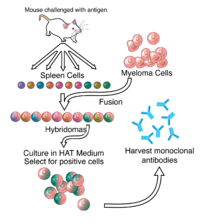
Photo from wikipedia
To monitor the residue of kitasamycin (KIT), a monoclonal antibody against KIT was prepared, and a 50% inhibition concentration (IC50) of 5.7 ± 1.4 μg/L was achieved with the most sensitive antibody, KA/2A9,… Click to show full abstract
To monitor the residue of kitasamycin (KIT), a monoclonal antibody against KIT was prepared, and a 50% inhibition concentration (IC50) of 5.7 ± 1.4 μg/L was achieved with the most sensitive antibody, KA/2A9, by optimizing ELISA conditions. The LODs for KIT in different animal tissues ranged from 22.47 μg/kg to 29.32 μg/kg, and the recoveries of the fortified tissues were 70% ~ 120% with coefficients of variation below 20%. Then, KIT-specific scFv KA/2A9/3 was prepared for the first time. Homologous modeling and molecular docking results indicated that the key amino acids of KA/2A9/3 scFv are TYR-92 (CDRL3), SER-93 (CDRL3), ASP-155 (CDRH1) and GLY-226 (CDRH3), and the hydrogen bond is the main force. And then, virtual mutation provides a method to evolve KA/2A9/3 scFv antibodies. These results contribute to comprehending the antigen-antibody binding mechanism and provide effective information for in vitro affinity maturation of anti-KIT scFv.
Journal Title: Food chemistry
Year Published: 2021
Link to full text (if available)
Share on Social Media: Sign Up to like & get
recommendations!